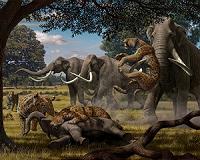 |
Bristol, England (UPI) Aug 19, 2010 Bats and moths, as predator and prey, are locked in an evolutionary "arms race" with survival as the goal, British researchers say. Studies have found that in the ongoing escalation, some bats have learned to emit "stealth" clicks that moths can't hear as they search for prey, while some species of moth have learned to tell the difference between "locating" clicks and "striking" clicks and can react accordingly, the BBC reported Thursday. Bats navigate and hunt by emitting a stream of ultrasound clicks and listening for the echoes in a natural form of radar, with the clicks coming faster and faster as the bats approach their prey. Some moths, when hearing the clicks, are known to reply with their own high-intensity "jamming" clicks, or to fly erratically in circling evasive maneuvers, or even simply drop out of the sky. Researchers say the battle between bats' strategies to hunt and the moths' strategies to avoid being eaten is a classic example of co-evolution. "It often seems like predators and prey are going through a continuous cycle or 'arms race', where each is trying to outwit the other," Hannah ter Hofstede, a University of Bristol researcher, said. "The predator is always trying to capture the prey and that selects for better defenses in the prey," she said. "Over evolutionary timescales, that causes gradual changes in both groups."
Share This Article With Planet Earth
Related Links Darwin Today At TerraDaily.com
 Humans said innocent in mammoth extinction
Humans said innocent in mammoth extinctionDurham, England (UPI) Aug 18, 2010 The disappearance of ancient grasslands, not human hunting, may have led to the extinction of animals such as the woolly mammoth, U.K. researchers say. Scientists at Durham University in England say the new findings challenge accepted theories that humans played a large part in the extinction of woolly mammoths, woolly rhinos and cave lions through hunting, competition for land and pres ... read more |
|
| The content herein, unless otherwise known to be public domain, are Copyright 1995-2010 - SpaceDaily. AFP and UPI Wire Stories are copyright Agence France-Presse and United Press International. ESA Portal Reports are copyright European Space Agency. All NASA sourced material is public domain. Additional copyrights may apply in whole or part to other bona fide parties. Advertising does not imply endorsement,agreement or approval of any opinions, statements or information provided by SpaceDaily on any Web page published or hosted by SpaceDaily. Privacy Statement |